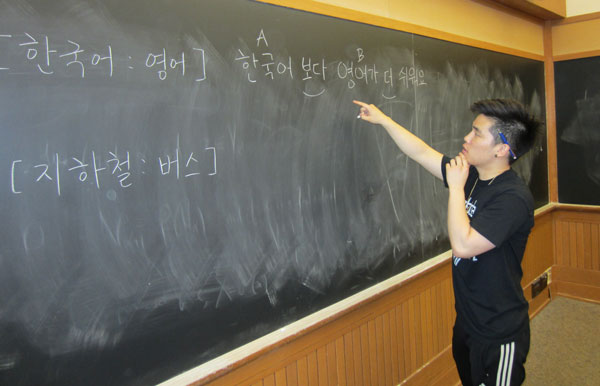by COURTNEY LEE
courtney@charactermedia.com
According to a recent study, the Korean language is one major exception to the overall downhill trend in foreign language enrollments across U.S. college campuses nationwide in the last several years.
A report by the Modern Language Association of America (MLA) has found that while combined enrollment in all languages other than English decreased by 6.7 percent between 2009 and 2013, enrollment in Korean saw the sharpest increase at 44.7 percent in that same time frame.
Although the actual number of enrollments in Korean is still relatively small (12,229) compared with top-studied languages such as Spanish (790,756) and French (197,757), the sudden jump from 8,449 to 12,229 enrollments in the span of four years reflects the Korean language’s growing popularity at U.S. institutions of higher learning.
Carol Schulz, director of the Korean Language Program in the Department of East Asian Languages and Cultures at Columbia University, told KoreAm in an interview Tuesday that students with no previous exposure to the Korean language or culture are generally learning Korean for fun.
“I think the Korean wave has a lot to do with it. Students watch [Korean] dramas more than I do,” she said. “They like Korean dramas, K-pop, and Korean culture.”
 French K-pop fans participate in a flash mob dance at the Louvre.
French K-pop fans participate in a flash mob dance at the Louvre.
According to MLA, among the top 15 studied languages, only Korean enrollments rose at all levels of higher institution: by 27.6 percent at two-year institutions, 45.3 percent at four-year institutions and 86.6 percent in graduate programs, based on the study’s findings.
The only other languages to experience a growth in enrollments between 2009 and 2013 were American Sign Language (19 percent), Portuguese (10 percent) and Chinese (2 percent), according to the study.
Schulz, who has worked at Columbia for more than 40 years and started the Korean Language Program from scratch, said there has been a steady increase in Korean enrollment among her students for the last several years, citing a 22 percent increase from last spring. In addition, the ratio of non-heritage to heritage students has risen significantly, she said.
Unlike heritage students, who have prior exposure to Korean culture and may have spoken and listened to it at home, non-heritage students have different learning needs that require more emphasis on these elements, Schulz said.
“In 2008, 71 percent of [Columbia] students [enrolled in Korean] were heritage and non-heritage students were 29 percent,” she said. “In 2014 and 2015, heritage speakers [comprised] 35 percent and non-heritage speakers [comprised] 65 percent of the entire student population enrolled in Korean courses.”
Schulz, who has a B.A. from Ewha Woman’s University in Seoul and masters’ from both Boston University and Columbia, said she had already begun working on new teaching materials in anticipation of a surge in the number of non-heritage students in her program.
“Five years ago, I predicted this would happen and it is exactly what happened,” Schulz said. “I don’t know what at that time made me think that way. I knew this was going to come. I started to develop learning material. Preparing the learning material doesn’t happen overnight. We’re prepared for this.”
At the University of Chicago, an increase in Korean language enrollment has not been as noticeable, said Ji-eun Kim, a lecturer in Korean language in the East Asian Languages & Civilizations department.
“Here at Chicago, we have a very small program so it’s hard to tell actually if it’s dramatically increasing because it’s different,” Kim said in an interview Tuesday. “This year, we have a relatively smaller [class]. Last year it was much larger.”
Nevertheless, Kim said, it’s clear at the university that the majority of students enrolled in Korean are “non-heritage” students. A first-year Korean class, on average, has only one or two students out of 10 who already had some exposure to the language, Kim said.
“We do a survey every year [that asks], ‘Why are you taking this class?’” Kim said. In the past, the instructor said, students were taking Korean because they were interested in Korean pop culture, dramas and K-pop.
“These days, the reasons are getting diverse,” Kim said. “Some students are taking it because it’s related to their major and some are taking it because they want to do something new, something different from what they’re used to. Some students have a long-term plan: after studying Korean, maybe they will move to Korea or work with a Korean company later on.”
___
Featured image courtesy of Columbia University









